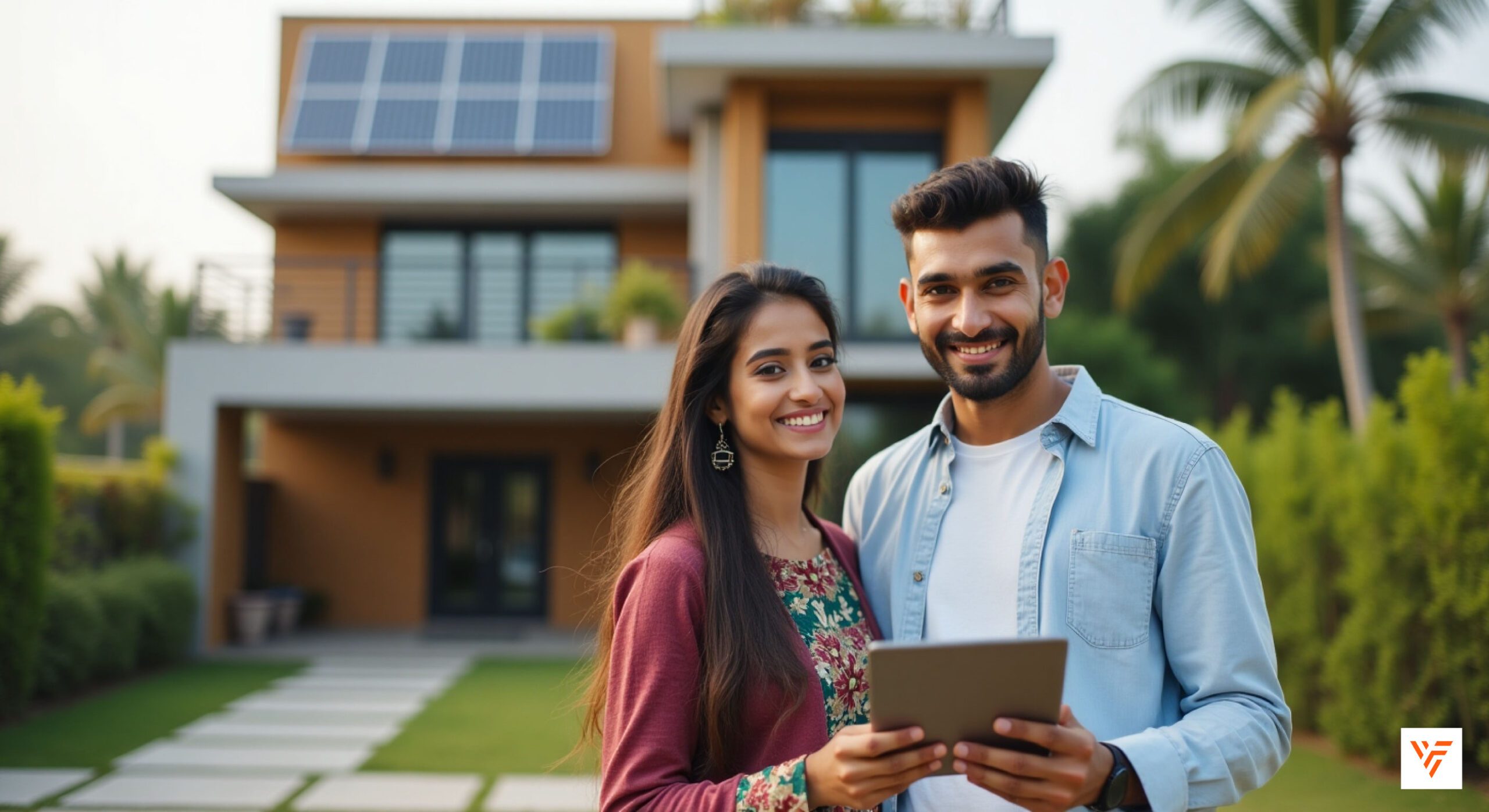In 2025, as India accelerates toward its net-zero emissions goal by 2070, green mortgages are transforming the homebuying landscape. With the real estate sector contributing 6% to India’s greenhouse gas emissions (TERI, 2024) and urban housing demand projected to reach 600 million homes by 2030 (NITI Aayog, 2024), eco-friendly home loans incentivize sustainable living. Banks like SBI, HDFC, and Bank of Maharashtra offer green mortgages with lower interest rates and higher loan-to-value (LTV) ratios for homes certified by the Indian Green Building Council (IGBC) or GRIHA. These loans support energy-efficient features like solar panels and rainwater harvesting, saving homeowners money while reducing environmental impact.
What Is a Green Mortgage?
A green mortgage is a specialized home loan designed to finance the purchase, construction, or renovation of energy-efficient homes certified by standards like IGBC, GRIHA, or LEED. These homes feature sustainable elements such as solar power, low-VOC paints, and water recycling systems. In 2025, with India’s green building market growing at 20% annually (FICCI, 2024), green mortgages offer lower interest rates (0.25-0.50% below standard rates), higher LTV ratios, and tax benefits, aligning with government initiatives like Pradhan Mantri Awas Yojana (PMAY) and RBI’s sustainable finance framework.
As a sustainable finance expert, I’ve seen green mortgages enable families to build eco-friendly homes while saving on costs. Whether you’re a first-time buyer in Bangalore or renovating in Chennai, this guide outlines the steps to secure a green mortgage in 2025.
Why Green Mortgages Matter in 2025

With 70% of Indian homebuyers prioritizing eco-friendly features (Knight Frank, 2024) and energy costs rising, green mortgages offer financial and environmental benefits. They reduce loan costs, lower utility bills by 30-50% (GRIHA, 2024), and enhance property value by 10-15% (Knight Frank). In 2025, with inflation at 4-5% (RBI, 2024), these loans align with India’s sustainability goals, making them a smart choice for cost-conscious and eco-aware buyers.
Step-by-Step Guide to Getting a Green Mortgage in India
1. Understand Green Mortgage Eligibility
Green mortgages require properties to meet specific energy-efficiency standards, typically IGBC, GRIHA, or LEED certification, with ratings like A or B on the Energy Performance Certificate (EPC). Applicants need a CIBIL score of 750+ for preferential rates, stable income, and standard KYC documents. For example, Bank of Maharashtra’s Maha Super Green Housing Loan Scheme requires green certification and a strong credit profile (Urban Money).
Actionable Tip: Check your property’s eligibility on igbc.in or grihaindia.org.
2. Research Lenders Offering Green Mortgages
Several banks and housing finance companies (HFCs) offer green mortgages in 2025, with competitive rates and incentives. Key players include:
- SBI Green Home Loan: Rates start at 6.50-6.90% vs. 7.00-7.40% for standard loans, with up to 90% LTV for loans up to ₹30 lakh (ClearTax).
- HDFC Green Home Loan: Offers 6.60-7.00% rates and cashback for IGBC-certified homes.
- Bank of Maharashtra Maha Super Green Housing Loan: Starts at 7.35% with flexible repayment (Urban Money).
- ICICI Green Home Loan: Provides 6.65-7.05% rates for green-certified properties.
- Bank of Baroda Eco Home Loan: Offers 6.55-6.95% rates with solar financing options (Bank of Baroda).
Actionable Tip: Compare rates on BankBazaar to find the best green mortgage deal.
3. Verify Property Certification
Lenders require properties to be certified by IGBC, GRIHA, or LEED, ensuring features like solar panels, energy-efficient appliances, or rainwater harvesting. For new builds, request a Predicted Energy Assessment (PEA) from developers. For existing homes, commission an EPC via grihaindia.org or local assessors. Properties with A or B ratings qualify for lower rates and cashback (Financial Express).
Actionable Tip: Ensure your property’s EPC is valid (issued within 10 years) to meet lender criteria.
4. Gather Required Documentation
Prepare the following documents, as outlined by Bank of Maharashtra’s green loan scheme (Urban Money):
- Identity Proof: Aadhaar, PAN, or Voter ID.
- Address Proof: Utility bills or passport.
- Income Proof: Salary slips, ITRs, or bank statements for salaried/self-employed applicants.
- Property Documents: Green certification (IGBC/GRIHA/LEED), sale agreement, and title deeds.
- Credit Score: CIBIL score of 750+ for better rates.
Actionable Tip: Use a lifetime free Step-UP Credit Card to improve your CIBIL score if below 750 (ClearTax).
5. Apply for the Green Mortgage

Submit your application online or via a bank branch. Lenders like SBI and HDFC offer digital portals for faster processing, typically 2-5 days for green loans. Provide accurate details, as false information can lead to rejection (ClearTax). Banks will assess your credit score, income, and property’s green certification before approval.
Actionable Tip: Apply through moneycontrol.com for streamlined comparisons and applications.
6. Leverage Government Incentives
Green mortgages align with PMAY, offering subsidies up to ₹2.67 lakh for eligible low-income buyers. States like Karnataka provide 5-10% property tax rebates for green-certified homes. Tax deductions under Section 24 (up to ₹2 lakh on interest) and Section 80C (up to ₹1.5 lakh on principal) apply (Financial Express).
Actionable Tip: Check PMAY eligibility on pmaymis.gov.in to maximize savings.
7. Make Energy-Efficient Upgrades
For existing homes, green mortgages can finance upgrades like solar panels or insulation. Bank of Baroda offers loans for solar installations with competitive rates (Bank of Baroda). These upgrades reduce utility bills by 30-50% and enhance property value by 10-15% (Knight Frank, 2024).
Actionable Tip: Work with IGBC-certified installers to ensure upgrades meet lender standards.
Benefits of Green Mortgages
| Benefit | Description | Impact |
|---|---|---|
| Lower Interest Rates | 0.25-0.50% below standard rates (6.50-7.35%). | Saves ₹3-5 lakh on a ₹50 lakh loan over 20 years. |
| Higher LTV Ratios | Up to 90% loan-to-value for green homes. | Reduces down payment burden. |
| Utility Cost Savings | 30-50% reduction in electricity/water bills. | Saves ₹50,000-₹1 lakh annually (GRIHA). |
| Tax Benefits | Deductions under Section 24, 80C, and PMAY subsidies. | Saves up to ₹4.17 lakh yearly. |
| Increased Property Value | 10-15% higher resale prices for green homes. | Boosts long-term investment returns (Knight Frank). |
Challenges of Green Mortgages
- Limited Availability: Green mortgages are offered by select banks, with fewer options in Tier-2 cities.
- Certification Costs: Obtaining IGBC or GRIHA certification can cost ₹50,000-₹1 lakh.
- Stricter Eligibility: Properties must meet green standards, limiting choices.
- Awareness Gaps: Many buyers are unaware of green loan benefits (Financial Express).
Actionable Tip: Consult a local IGBC assessor to navigate certification requirements.





